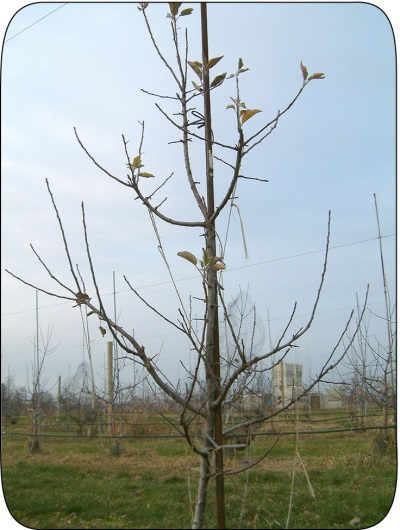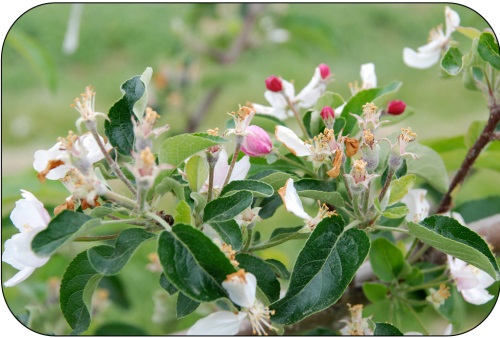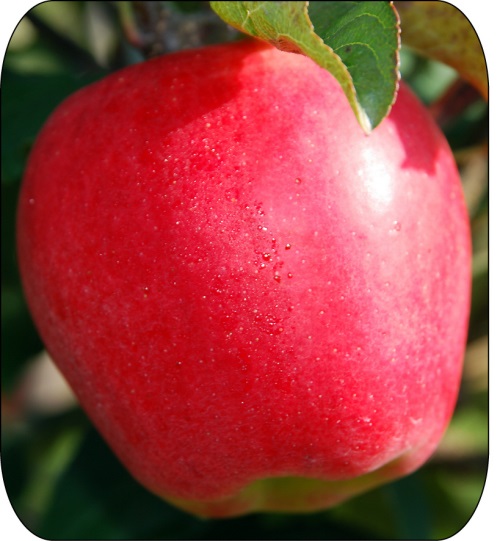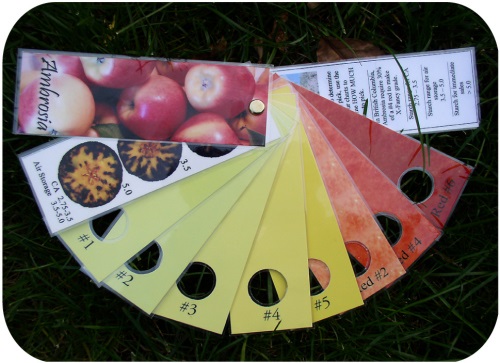Commercial production of Ambrosia™ apples in Ontario
Learn about Ambrosia™ tree and fruit characteristics, harvest timing, thinning, rootstocks, disease and insect susceptibility and storage.
ISSN 1198-712X, Published August 2009
Introduction and Origin
Ambrosia™ is a naturally occurring chance seedling found in 1990 in a cultivated plum orchard previously planted to Golden Delicious and Starking Delicious in British Columbia. Its parentage is unknown but possibly is a seedling of a cross from Starking Delicious and Golden Delicious. After discovery, the cultivar was propagated by budding and further testing showed the cultivar to be stable without significant reversions (Figure 1).
Figure 1. Ambrosia™ is a medium to large-fruited bi-colour apple cultivar with a unique sweet flavour.
Tree Characteristics
Ambrosia™ has an upright, growth habit, with moderate vigour, spur fruit development and relatively low precocity (Figure 2). Its vigour depends on soil type and rootstock and varies based on environment and cultural management. The tree has a tendency for strong lateral branch development and upright growth. As the tree matures, more spur pruning may be required to maintain vigour and fruit size. In their formative years, Ambrosia™ trees require judicial branch selection and tying down of branches to establish productive trees that are easier to manage.
Significant tree training in the first two years after planting is very important for the overall development of well-angled fruiting branches and overall orchard management and productivity.
Figure 2. Ambrosia™ trees have an upright and somewhat spurry growth habit similar to Red Delicious. Unlike other cultivars, leaves remain on the trees late in the autumn. Early training and branch tying is necessary for Vertical Axis and Slender Spindle training systems.
Ambrosia™ blooms mid to late in the blossom period and produces medium pink and white flowers with broad elliptic petals. Not unlike Gala, weaker flowers on one-year-old wood open later, which have a tendency to form smaller fruit and pre-dispose the tree to fireblight because of the protracted bloom period (Figure 3). Application of a second chemical thinning spray to abscise fruitlets set from these flowers may be necessary. Ambrosia™ appears to be pollinated by any diploid cultivar flowering in the same season. Information on cold hardiness is unknown at this time, however Ambrosia™ is reported to be very sensitive to frost and cool spring temperatures. Also, similar to Red Delicious, Ambrosia™ is susceptible to dormant oil spray damage.
Figure 3. "Rat-tail" bloom of Ambrosia™ trees at flowering can lead to smaller fruit size if these fruits are not later thinned.
Fruit Characteristics
Ambrosia™ fruit are medium in size ranging from 6.8-7.5 cm diameter and averages 210-220 grams when adequately thinned. Fruit are globose conical and angular in shape with slight calyx lobing and a wide eye basin. The skin is thin and not prone to russet, with slight prominence of lenticels. Ambrosia™ is a bi-colour apple with creamy yellow background colour and pink/red blush that develops more red in cooler regions (ranging from 50 per cent to 90 per cent) (Figure 4). The flesh is fine-grained, cream coloured and has a unique sweet sub-acid flavour. It has a juicy crisp texture which, combined with its thin, glossy skin, adds to its high palatability. Similar to Cortland and Honeycrisp, the flesh is also slow to oxidize, and is therefore suitable for salads, fruit trays, and fresh displays.
Ambrosia™ typically matures in late September to early October in Simcoe, and requires one to two picks. In cooler regions of Ontario (e.g. Durham Region), most fruit can be harvested in one pick. Fruit qualities including firmness, taste, and storage potential can be compromised by late harvest. To achieve the best red colour, do not delay harvest.
Figure 4. Ambrosia™ is a bi-coloured apple with a pinkish red blush on creamy yellow background. Colour may be enhanced in cooler regions, however adequate growing degree-days are required for full fruit maturity. Considering its likely genetic parentage (Red Delicious), it is anticipated to be better adapted to the warmer growing regions of Ontario.
Harvest Timing
Ambrosia™ is a low producer of ethylene and does not display the classic climacteric rise at harvest of many cultivars. Baseline levels of less that 1 ppm ethylene during periods of ripening have been characterized. Therefore internal ethylene concentrations are not a good indicator of fruit maturity and when to start harvesting. Growers in British Columbia use skin colour and starch staining charts for optimal harvest (Figure 5). This has helped to standardize fruit quality among growers.
Therefore, the current recommendation in Ontario is to harvest Ambrosia™ based on starch index. The amount and intensity of red blush colour development is not a good indicator of maturity as it is affected by tree nutritional status and light and temperatures close to harvest.
- Once sufficient starch clearing has occurred, harvest all fruit meeting minimum colour requirements.
- A second harvest may be made within a week.
- Begin fruit harvest when the starch index rating is between 2.75-3.5 for controlled atmosphere (CA) storage (5-6 months storage), between 3.5-5.0 for air storage, and greater than 5.0 for immediate retail.
- Fruit surface colour of #4 red (Figure 5) covering 30 per cent of the surface is required to make extra fancy grade.
Ontario research indicates that:
- increases in yellow background colour (particularly in the calyx end of the fruit)
- loss in firmness and
- increases in starch index values
are all good indicators of when to begin harvest.
In B.C., the average starch movement is 1.5 points per week (on a 9 point scale), and in warm harvest periods starch movement can be more rapid , making the harvest window of 7-10 days shorter in comparison to many other cultivars.
Colour Requirements
Current colour requirements for Ambrosia™ packing is 30 per cent #4 red colour for Extra Fancy and 25 per cent #2 red colour for Fancy. Often nearly 80 per cent of fruit can be harvested in the first pick. Most growers fail to pick deep enough on the first harvest.
- Pick right to the minimum colour for Extra Fancy.
- Be sure not to wait until the background is yellow to harvest, as the fruit will be over-mature for storage.
- Background colour is more closely associated with fruit nitrogen levels than maturity and often background colour changes with time in storage.
Figure 5. Use of a blush/ground colour and starch-staining chart is recommended for determining optimal harvest. Ambrosia™ colour charts are available to growers through the New Variety Development Council (BC).
Thinning
Ambrosia™ blooms heavily and is sensitive to chemical thinning, particularly when trees are young.
- Fruit set can vary, even when sufficient bloom and pollination conditions are apparent.
- A target crop load of approximately 6 fruits/cm2 trunk area (measured approximately 15-20 cm above the bud union) is recommended to produce the highest quality fruit and to avoid biennial bearing (Figure 6; Table 1).
- Ambrosia™ is sensitive to benzyl adenine sprays (6-BA), carbaryl and NAA. Wait until fruitlets reach 8-12 mm before applying chemical thinners.
- For further information on chemical thinning, see OMAFRA Publication 360, Fruit Production Recommendations.
Figure 6. Ambrosia™ trees on M.9 rootstock in their 5th leaf. Fruit size and quality have been excellent at harvest. Judicial crop load management, tree training, and irrigation have all helped in achieving this success.
Rootstocks
Ambrosia™ is a low-medium vigour cultivar and therefore use a dwarf or semi-dwarfing rootstock of M.9 EMLA or greater vigour. Trees on Malling 9 (M.9 E) have performed well for supported plantings at tight in-row spacing. This rootstock encourages earlier fruiting of the relatively low precocious cultivar.
Performance on Bud.9 has been similar to M.9, with slightly greater reported tree vigour. Bud.9 has the added benefit that it is more winter hardy and more resistant to fireblight than M.9E. Trees on M.26 have been less precocious than M.9, but this rootstock is a good choice for high density plantings in poorer soils. Stake all trees including M.26.
Disease and Insect Susceptibility
Since Ambrosia™ is a relatively new cultivar, information on its disease and insect susceptibility profile are not well known. The information available at this time indicates that Ambrosia™ is susceptible to Campylomma (Mullein Bug) damage, and like Red Delicious can be prone to mite damage. Ambrosia™ is very susceptible (perhaps equal to McIntosh) to Venturia inaequalis (apple scab) and has a medium to high susceptibility to Erwinia amylovora (Fire blight).
Storage
Ambrosia™ fruit can exhibit calyx bowl splitting, pre-mature breakdown and soft scald if harvested over mature. CA storage reduces, but will not adequately control flesh breakdown in late-picked fruit.
Fruit tend to soften very quickly in extended regular 'air' storage; use controlled atmosphere storage for storage beyond 60-90 days, particularly for optimal firmness and flavour retention. Ambrosia™ should respond well to SmartFresh (1-MCP), because of the inherently low levels of ethylene when apples are pre-climacteric.
In B.C. pre-harvest foliar calcium sprays have improved post-harvest storage of Ambrosia™.
In addition, high fruit nitrogen and low phosphorus levels have resulted in poorly coloured fruit and lower fruit flesh firmness, suggesting that proper care of the nutritional status of the orchard is important for optimum fruit quality and storage potential. For current recommendations for storing Ambrosia™ in CA, see the OMAFRA website at Ontario.ca/crops.
Availability
Ambrosia™ is protected under the U.S. Plant Patent Act (Plant Patent No. 10789). It may be propagated only by licensed parties. To prevent oversupply, Ambrosia™ is being grown on limited acreage in Canada and the U.S. At the time of print, all trees delivered after July 1, 2005 were subject to a royalty fee of $3.75/tree; however these fees could be adjusted as marketing strategies are developed.
Firms or individuals desiring to propagate and sell trees of Ambrosia™ must apply for a license from the Okanagan Plant Improvement Company, 4200 Hwy 97, P.O. Box 6000, Summerland, British Columbia, Canada V0H 1Z0.
Table 1. Relationship between planting density, potential yield, and number of fruit required per tree1
Tree Spacing | Tree Spacing | Density | Apples required per tree based on tree vigour and cropping potential2 | |||||
|---|---|---|---|---|---|---|---|---|
(ft) | (m) | (ft) | (m) | trees/acre | trees/ha | Low | Medium | High |
1.50 | 0.46 | 8.0 | 2.44 | 3632 | 8970 | 17 | 21 | 27 |
1.50 | 0.46 | 9.0 | 2.74 | 3228 | 7973 | 19 | 24 | 30 |
1.75 | 0.53 | 8.0 | 2.44 | 3113 | 7689 | 20 | 25 | 31 |
1.50 | 0.46 | 10.0 | 3.05 | 2905 | 7176 | 21 | 27 | 33 |
1.75 | 0.53 | 9.0 | 2.74 | 2767 | 6834 | 22 | 28 | 35 |
1.50 | 0.46 | 11.0 | 3.35 | 2641 | 6524 | 23 | 29 | 37 |
1.75 | 0.53 | 10.0 | 3.05 | 2490 | 6151 | 25 | 31 | 39 |
2.00 | 0.61 | 9.0 | 2.74 | 2421 | 5980 | 25 | 32 | 40 |
2.00 | 0.61 | 10.0 | 3.05 | 2179 | 5382 | 28 | 36 | 44 |
1.75 | 0.53 | 12.0 | 3.66 | 2075 | 5126 | 30 | 38 | 47 |
2.00 | 0.61 | 11.0 | 3.35 | 1981 | 4893 | 31 | 39 | 49 |
2.00 | 0.61 | 12.0 | 3.66 | 1816 | 4485 | 34 | 43 | 53 |
2.50 | 0.76 | 10.0 | 3.05 | 1743 | 4306 | 35 | 45 | 56 |
2.50 | 0.76 | 11.0 | 3.35 | 1585 | 3914 | 39 | 49 | 61 |
2.50 | 0.76 | 13.0 | 3.96 | 1341 | 3312 | 46 | 58 | 72 |
2.50 | 0.76 | 13.0 | 3.96 | 1341 | 3312 | 46 | 58 | 72 |
3.28 | 1.00 | 11.5 | 3.50 | 1157 | 2859 | 53 | 67 | 84 |
3.00 | 0.91 | 14.0 | 4.27 | 1038 | 2563 | 59 | 75 | 93 |
3.28 | 1.00 | 13.1 | 3.99 | 1014 | 2505 | 60 | 77 | 95 |
5.00 | 1.52 | 14.0 | 4.27 | 623 | 1538 | 98 | 125 | 155 |
6.00 | 1.83 | 15.0 | 4.57 | 484 | 1196 | 126 | 161 | 200 |
1Assuming 88 count size fruit (216 gram average) at harvest and tree are mature bearing.
2These are guidelines only. Adjustments may be necessary in individual orchards, especially with very low or very high vigour blocks.
References
- Grower Workshop for Ambrosia™ Apple Proceedings, January 23, 2001. Summerland, B.C., 12 June 2009.
- Apples: Ambrosia. June 12, 2009.
- Guide to Fruit Production, Publication 360, OMAFRA.
- DeEll, J. 2012. Controlled Atmosphere Storage Guidelines and Recommendations for Apples, Ontario Ministry of Agriculture, Food and Rural Affairs. Order Number 12-045.
- Hampson, C. R. and D.L. McKenzie, D. L. 2006. Sensory characteristics of 21 new apple cultivars after short-term cold air storage. Journal of the American Pomological Society 60(1): 9-19.
- Hampson, C., R. McNew, R. Crassweller, D. Greene, S. Miller, L. Berkett, M.E. Garcia, A. Azarenko, T. Lindstrom, M. Stasiak, W. Cowgill, G. Greene. 2007. Performance of apple cultivars in the 1999 NE-183 regional project planting. III. Fruit sensory characteristics. Journal of the American Pomological Society 61(2): 115-126.
- Mennell, W. 2002. Ambrosia™ - a home-grown B.C. apple. Compact Fruit Tree 35(2): 63-64.
This factsheet was written by Dr. John A. Cline, Associate Professor, Ontario Agriculture College, University of Guelph, Department of Plant Agriculture, Simcoe Campus. The author would like to thank Debbie Norton, Agricultural Technician (University of Guelph), Dr. Robert A. Cline, Research Scientist (retired, Horticultural Research Institute of Ontario), Paul Frankis and Charles Stevens, apple producers, Leslie Huffman, Apple Specialist (OMAFRA), and Dr. Jennifer DeEll, Fresh Market Quality Program Lead (OMAFRA) for reviewing and contributing to this document.





